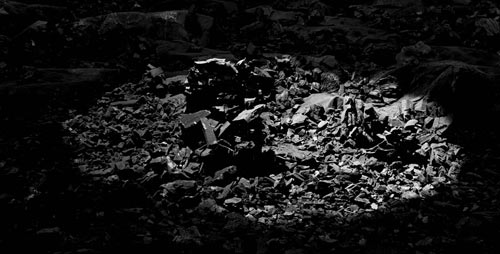Scenario, an exhibition by Dina Shenhav, describes an unknown place that has suffered a catastrophic reality. Shenhav calls attention to the earliest, primeval human fear of apocalyptic situations. This fear is based on the presence of spectacular events from the dawn of history to the present time - places that experienced destruction, ruin and devastation caused by man and civilization or by acts of nature. Biblical stories of Noah and Sodom, the destruction of Pompeii, the Holocaust, the atomic bombing of Hiroshima, the attack on the Twin Towers, wars, terrorism, violence, earthquakes, avalanches, forest fires and the terrifying destructive force of tsunamis - all these are engraved into the human genome. While they occur, these devastating situations are reported incessantly in the various media, mesmerizing the viewer and intensifying human anxiety. Hollywood studio special effects also facilitate imaginary fantasies of destruction to penetrate reality and are seen as the “ultimate ‘effect’” of the Real. But “the Real itself, in order to be sustained, has to be perceived as a nightmarish unreal specter.”* Different from other artists, whose interest in violence and destruction usually relates to concrete events - particularly German artists such as Hans Haacke (in the work, Germania, shown in 1993 in the German Pavilion in Venice), Anselm Kiefer or the writer Winfried Georg Sebald - and continuing Shenhav’s earlier work, City (2002) and End of the Forest (2008), the installation has no specific description and deals mainly with structured spaces of anxiety in human existence. The real catastrophe, as described by Slavoj Žižek, is life shadowed by the constant threat of catastrophe (ibid).
Scenario simulates a dark present, gloomy and desolate, with no remains of the past, of history and culture. Shenhav transfers to the present time a nightmare that has occurred innumerable times, and the paralyzing and horrifying probability of its happening in the future - a kind of nightmare made real. ** However, while analysis of a scientific scenario based generally on factual assumptions and past events is intended to produce a positive approach to avoiding mistakes, and offers a practical strategic solution for concrete aims, one cannot avoid the recurrence of Shenhav’s Scenario or prepare for it, and the tools to confront it are futile and useless. The searchlight looking for a sign of life indeed signifies life and hope, but also hints at the viewer’s hypnotized stare in situations of disaster, his yielding to watching these events over and over again, and the combination of dread and awe he experiences. Although the moon in its fullness and radiance and the meditative rise and fall of the sea symbolize the force of nature and the continuity of life, Shenhav leaves the viewer exposed and vulnerable: consoled by nature but gripped by terror, shocked by the horror, but also thrilled by its power.
* Žižek, Slavoj, Welcome to the Desert of the Real, London and New York: Verso, 2002.
** A more extreme example of this type of scenario can be found in the book by Orly Castel-Bloom, 1997 (published in Hebrew in 1992). Dolly City, France: Loki Books/Unesco Publishing
| | | | View the installation | | |
| | | |  | | Scenario, Installation (detail), 2011 | | |  | Dina Shenhav, Illumination (video, detail) , 2011
Photography: Avner Shahaf
Editing: Doron Solomons
| | |
|